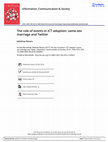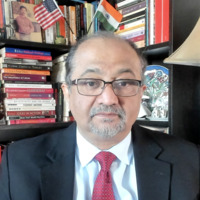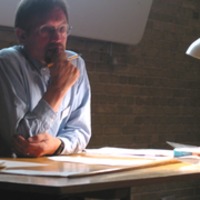Papers by Matthias Revers

The American Sociologist
US-American sociology has largely failed to examine the transformation of mediated
communication... more US-American sociology has largely failed to examine the transformation of mediated
communication of the past 20 years. If sociology is to be conceived as a general social
science concerned with analyzing and critically scrutinizing past, present, and future
conditions of collective human existence, this failure, and the ignorance it engenders,
is detrimental. This ignorance, we argue, may be traced back to the weak self-identity,
institutionalization and position of media sociology in the discipline. Our argument
here is threefold: 1) There was an opportunity structure for specialization, that is, a
venerable research tradition in media sociology since the first half of the 20th century.
This tradition links back to classics in sociology and peaked at a time (1970s and
1980s) when the discipline differentiated institutionally and many new sections
emerged in the American Sociological Association. 2) Despite this tradition, media
sociology has not become an established in sociology in the United States until
recently. 3) Lastly, we locate reasons for non-establishment on three distinct but
interconnected levels: the history of ideas in media sociology,
institutional/disciplinary history, and disciplinary politics.

ICT adoption is predominantly considered as a process conditioned by social structures, social si... more ICT adoption is predominantly considered as a process conditioned by social structures, social situations of adopters, and attributes and features of technologies. What is often overlooked are the cultural forces that shape adoption experiences and processes. This paper focuses on events and event narratives as vehicles through which the efficacy of culture unfolds in technological change processes. Cultural sociologists have demonstrated the influence of events for collective beliefs and action. This article considers the power of one event on a much smaller scale: The passage of same-sex marriage (SSM) law in New York in June 2011 was not only significant for marriage equality in the US but also for the operating logic of the news ecosystem in which the political decision was made—the state house in Albany. For the journalists who covered this event on the ground, the SSM decision was the catalyst to fully embrace Twitter. Years later, the event still served as an exemplar for the potentials of Twitter and as a basis of legitimacy of associated tweeting practices reporters incorporated. This contribution is based on ethnographic research at the state house in Albany, analysis of tweets and legacy news coverage published during that period, and in-depth interviews with reporters.

This contribution is written against the backdrop of the historic dispersal of early American med... more This contribution is written against the backdrop of the historic dispersal of early American media sociology out from the core concerns of the discipline and into various importer academic disciplines (including communication, journalism, and media studies) and an ever-growing pervasiveness of media in everyday life which is ref lected by a resurgence of sociological scholarship in the United States since the early 2000s. The article divides the field in works that study media inwards – along the threefold dimensions of production and technologies, communication and discourse, reception and effects – and works that study media outwards. We argue that this latter perspective, examining broader theoretical, methodological, and substantive social implications of mass-mediated communication, is the most promising one for a mature field of American media sociology. On this basis, we conclude with some suggestions regarding possible new, and as of yet understudied, lines of inquiry for future media sociologists.

Digital Media and the Diversification of Professionalism: A US-German Comparison of Journalism Cultures
The Crisis of Journalism Reconsidered, Jun 2016
Variations of adopting digital media, particularly tensions and negotiations in adoption processe... more Variations of adopting digital media, particularly tensions and negotiations in adoption processes, mark points of departure of technological change. This comparative study of social media adoption in journalism reveals two concurrent tendencies: 1) diversification of professionalism, accompanied by an increasingly hybridizing media environment and 2) corroboration of professionalism, connected to normalizing new technologies.
Aside from a shared crisis awareness of legacy news and similar experiences of accelerated news cycles, particularly social media adoption reflects profound differences between the US and Germany. Social media served more to reproduce than alter occupational norms for German journalists. US journalists, on the other hand, adapted their occupational roles and expanded boundaries of professionalism through social media. Especially Twitter featured US reporters as more willing to introduce more transparency of their daily practice. Structural differences of media systems can not account for these differences entirely. Adoption patterns are explicable in large part by distinct cultural commitments and professional imaginaries of journalism in these two countries.
This chapter is based on qualitative research on two state political press corps in the US and Germany, conduced between 2009 and 2012, and an analysis of discourses of journalistic professionalism in both countries.
Cultural sociology reaches back to classical thinkers in sociology. In the wake of the ‘cultural ... more Cultural sociology reaches back to classical thinkers in sociology. In the wake of the ‘cultural turn,’ cultural sociology constitutes itself drawing on various theoretical resources from the social sciences and humanities: critical theory, cultural anthropology, phenomenology, structuralism, and poststructuralism among others. After its institutionalization in major associations during the 1980s, cultural sociology today represents a vibrant subfield and in some ways a paradigm that permeates other areas of sociological inquiry.

Agents of Democratic Accountability? Professional Culture of Political Journalism in the US and Germany
Newspaper journalism in the early 21st century is experiencing economic predicaments and a crisis... more Newspaper journalism in the early 21st century is experiencing economic predicaments and a crisis of professional authority, both connected to technological changes of public communication. This is the backdrop of this study of political journalism. It is based on three years of qualitative field research on political press corps in Albany, New York and Munich, Germany, encompassing 72 interviews with reporters (from 31 news organization) and spokespeople (across all political parties and branches of government) as well as about 350 hours of observation. It also draws on professional discourses, including news stories about journalism (meta-journalism), obituaries of journalists as well as journalism award statements.
The main question this research addresses is what defines professional cultures of US and German political journalism and how are they expressed in professional discourse and performances. It also examines how professional culture affects competition and autonomy maintenance towards politics. Accounting for technological changes, it also asks how the adoption of online media is mediated by established notions of professionalism and how professional culture is reshaped by new practices in turn.
Although there are tendencies towards more subjective assessments in the news (e.g. analysis) in both contexts, opinion is still a taboo for US journalists, engendering complex purification rituals. Professional role conceptions also differ regarding interventionism. While obedient reproduction of political messages is uniformly obsolete, the German press culture seemed more reserved in terms of changing the political status quo, exposing the private lives of politicians and honoring more aggressive journalistic efforts in this regard. The US press corps champions a competitive culture, which is not free from collegiality, while the German press corps is rooted in an associational culture defined by formal and informal solidarity. Corresponding to the taboo of opinion (and thus partisanship), the professional performance of reporters needs to assert more distance to the political realm in the US than in Germany. Finally, the German press culture is much less affected by news digitization and seized by social media. This is explicable by the relative vitality of the news industry, strong privacy concerns in Germany and the professional culture’s inertia to change.
Twitter makes visible some of the most fundamental divides in professional journalism today. It r... more Twitter makes visible some of the most fundamental divides in professional journalism today. It reveals tensions about what constitutes news, the norms guiding journalists providing it, professional identity, and public service. This article argues that these tensions result from a clash between the institutional logic of professional control (Lewis, 2012) and an ethic of transparency. Drawing from extensive research on a political press corps, involving observation, interviews, and analysis of tweets, this study witnesses the adoption of Twitter in the everyday working practices of reporters. It thereby also provides reasons why Twitter has been so successful in journalism. Tensions between professional control and transparency in journalism may, furthermore, be emblematic for divides in other professions today.

This article deals with the intertwining of digital and nondigital spaces of news reporting. It f... more This article deals with the intertwining of digital and nondigital spaces of news reporting. It focuses specifically on how Twitter affects spatial and temporal orderings of news ecosystems. At the New York State Government, actors within the space permeate informational barriers through Twitter while enabling others to follow and engage in events from remote locations. The always-on mentality of tweeters not only blurs boundaries between work life and private life but also helps correspondents to get access to and pass on information instantly as well as to better anticipate events. The proliferation of digital spaces enhances awareness of nondigital spaces but requires coordination between the two. This paper is based on over two years of field research, involving observation, interviews, digital ethnography of the statehouse twitterverse and content analysis of journalists’ tweets around the passage of same-sex-marriage law.

Journalism: Theory, Practice and Criticism, Jan 2014
In addition to power struggles over representation, negotiations between journalists and news sou... more In addition to power struggles over representation, negotiations between journalists and news sources represent complex boundary problems. Journalists’ efforts at asserting autonomy and offsetting instances when they give it up all provide valuable insights into their understanding of professionalism. The state house, where political actors attempt to influence media representations every day, provides a strategic research site (Merton, 1987) for studying professionalism in source relations. This ethnographic analysis of the Albany press corps looks at professional meanings that are expressed in these negotiations. In interviews conducted for this study, journalists define and distinguish themselves from each other primarily in terms of their understandings of what dealing with source negotiations professionally means. This article introduces the concept of boundary performance to explore how news workers express journalistic professionalism symbolically in action.

Media Systems and Media Cultures: News Coverage of Deportation in the US and Austria
"The public sphere and its ability to ensure political accountability is once again a pressing is... more "The public sphere and its ability to ensure political accountability is once again a pressing issue in times of Wikileaks and successful democratic movements in North Africa and the Middle East. Media systems–news media understood by their power relations to state, market, and civil society–are the key institutions to fulfill this purpose of public spheres, even in times of social media.
This project studies media systems of the US and Austria, starting from two case studies of politically controversial deportation cases (Elián González and Arigona Zogaj). Newspaper coverage does not only reflect power relationships within these media systems but, connected to this, journalistic cultures and traditions. In addition to these cases, which are analyzed according to framing and narrative structures, interviews with journalists in both national contexts provide insights about the underlying occupational practices. This research design aims at a deeper understanding of causal processes of purposefully selected cases, which have wider implications and can expand previous theoretical assumptions.
Even though the selection of newspapers is based on a most-different-comparison, the analysis shows that the New York Times and the New York Post are not so different from each other covering the highly politicized Elián González case compared to how the Austrian papers covered the Arigona Zogaj affair, which was not less controversial. While the editorial sections reflect the divergent political positions of these papers, these do not translate as much into the news sections of the US papers.
This report locates the basis for these differences (and blind spots in Austrian media coverage) at three main conditions: less political parallelism coupled with higher commercialization of the US media system, higher professionalization of the journalistic field, and different professional traditions.
Political parallelism does not mean media adopting political ideologies uncritically but aligning of thematic emphases with political actors. This seems to be more difficult to avoid in a pluralistic party system than in a de facto binary system. This means that in a single medium in Austria (and continental Europe for that matter, according to the research literature) certain debates do not take place. News discourse in the Times and in the Post, in comparison, is more similar, even they couldn’t be more different in terms of rhetoric, layout, and political standpoints.
The higher portion of journalists with a journalistic education (45% compared to 0% in Austria) is a measure for higher professionalization in the US. Occupational practices and ethics have an immediate effect by graduates of journalism schools enacting these principles in media organizations. Furthermore, journalism schools publish academic journals and participate in mass-mediated venues and thus affect professional discourse more indirectly as well. This creates institutional norms which makes media organizations more similar to each other (normative isomorphism).
These norms are connected to a traditional perception of journalism, whose central component–the so-called objectivity norm–leads to more equal weight of different perspectives, even those a respective outlet/journalist may reject ideologically. Connected to this, the relatively strict editorial and staff division between news and opinion in the US (which is not the case in Austria as well as in most other European media systems) appears to be critical.
Finally, it should be mentioned that a more one-sided news coverage in each outlet might not be as crucial in the age of media consumption across numerous news outlets on the internet. Furthermore, the theoretical assumption of consuming one particular outlet that provides all debates available in news discourse does not say anything about the spectrum news discourse as a whole provides. This project cannot provide definitive answers to this question but raise assumptions, for instance regarding the relative lack of more “structural debates” (e.g. about the Cuban embargo, children’s rights, immigration policy) coupled with an emphasis on the continuous PR-steered flow of human interest stories about Elián González. Not even the Times was innocent of that and this indicates a certain discursive underexposure of the field as a whole."
The American Sociologist, Jan 1, 2009
Book Reviews by Matthias Revers
In the third part of this book, some contributors present empirical results assessing how mediati... more In the third part of this book, some contributors present empirical results assessing how mediatization progresses and manifests itself (D'Angelo et al.; Donges and Jarren; Shehata and Strömbäck; Udris and Lucht). Other authors make arguments -based on literature reviews -for how mediatization can be linked to other theories of the relationship between politics and media, such as framing (de Vreese) or political agenda setting (van Aelst et al.).
Acta Sociologica, Jan 1, 2009
Drafts by Matthias Revers
Conference Presentations by Matthias Revers

Flucht, Öffentliches Räsonnement und Engagement: Der Fall Zogaj und danach.
Der dramatische Abschiebefall der kosovarischen Familie Zogaj war in den Jahren 2007 bis 2010 Anl... more Der dramatische Abschiebefall der kosovarischen Familie Zogaj war in den Jahren 2007 bis 2010 Anlass für Solidaritätsbekun- dungen und öffentliche Debatten über „gute Integration“ und Asylrecht in Österreich. Dieser Beitrag vermisst den medialen Diskurs von 2007 bis 2010 in den Tageszeitungen Der Standard und Kronen Zeitung auf inhalts- und narrationsanalytischer Ebe- ne. Anhand dessen werden Flucht und Flüchtlinge als Symbole nationaler Identitätsbestimmung von Gastländern diskutiert, die punktuell (wie im Falle Zogaj) zu partiellem zivilgesellschaftlichen Konsens führen, aber größtenteils Projektions ächen unter- schiedlicher politischer Interessen in der Öffentlichkeit bleiben. Den nachhaltigsten Beitrag leistete die Zogaj-Debatte zur Genese einer diskursiven Opportunitätsstruktur, in der zivilge- sellschaftliches Engagement – etwa Anti-Abschiebungsproteste nach 2007 und Willkommenskultur in der derzeitigen Flüchtlings- krise – stattgefunden hat. Schließlich wird der Ein uss sozialer Medien (die 2007-2010 noch eine untergeordnete Rolle spielten) auf die Strukturierung der Flüchtlingsdebatten-Öffentlichkeit diskutiert.
Books by Matthias Revers
This book challenges the idea that Western media systems are becoming more American in the digita... more This book challenges the idea that Western media systems are becoming more American in the digital age, arguing that journalistic cultures are not only significantly different from each other still but also variably open and resistant to change. Drawing upon extensive field research of political reporters and examination of discourses of journalistic professionalism as well institutional analysis, this book finds that occupational norms and values of journalism in the US are vigorously upheld but in fact relatively porous and malleable. In Germany, by contrast, professional boundaries are rather strong and resilient but treated matter-of-factly. Revers argues that this is both a consequence of institutional arrangements of media systems and historically evolved cultural principles of journalism in both countries which mutually constitute each other.
Articles & Book Chapters by Matthias Revers

Sociology of Journalism (proofs)
Sociological inquiries into journalism have considered journalism as the product of cultural, eco... more Sociological inquiries into journalism have considered journalism as the product of cultural, economic, political, and technological forces in different times and spaces. As part of (and like) the field of media sociology, the sociology of journalism is an interdisciplinary subfield. It has several objectives of inquiry: examining situational and larger cultural differences of journalisms; analyzing sys-temic complexities in which journalism arises (i.e. technological formats and change, events, normative crises or organizational structures); illuminating intended and unintended consequences of practical routines of journalism; and exploring long-term patterns of professional, institutional, and organizational changes in journalism. Analyzing journalism through the sociological prism is central for understanding its larger societal implications and a continuous reminder that journalism studies is not an end in itself. Starting in the late 1950s, the gradual relocation of sociology of journalism from sociology to communication coincided with the establishment and professionalization of the two social science disciplines in US academia. Even as communication science has now produced generations of graduates in its own doctoral programs, the intellectual centrality of the sociology of journalism continues and has been recently confirmed through the post-financial crisis academic hires. This paper introduces some of the major strands of the sociology of journalism research from the beginning of the 20th century to today. It also argues that the sociology of journalism took on a new ideational and professional significance within the field.











Uploads
Papers by Matthias Revers
communication of the past 20 years. If sociology is to be conceived as a general social
science concerned with analyzing and critically scrutinizing past, present, and future
conditions of collective human existence, this failure, and the ignorance it engenders,
is detrimental. This ignorance, we argue, may be traced back to the weak self-identity,
institutionalization and position of media sociology in the discipline. Our argument
here is threefold: 1) There was an opportunity structure for specialization, that is, a
venerable research tradition in media sociology since the first half of the 20th century.
This tradition links back to classics in sociology and peaked at a time (1970s and
1980s) when the discipline differentiated institutionally and many new sections
emerged in the American Sociological Association. 2) Despite this tradition, media
sociology has not become an established in sociology in the United States until
recently. 3) Lastly, we locate reasons for non-establishment on three distinct but
interconnected levels: the history of ideas in media sociology,
institutional/disciplinary history, and disciplinary politics.
Aside from a shared crisis awareness of legacy news and similar experiences of accelerated news cycles, particularly social media adoption reflects profound differences between the US and Germany. Social media served more to reproduce than alter occupational norms for German journalists. US journalists, on the other hand, adapted their occupational roles and expanded boundaries of professionalism through social media. Especially Twitter featured US reporters as more willing to introduce more transparency of their daily practice. Structural differences of media systems can not account for these differences entirely. Adoption patterns are explicable in large part by distinct cultural commitments and professional imaginaries of journalism in these two countries.
This chapter is based on qualitative research on two state political press corps in the US and Germany, conduced between 2009 and 2012, and an analysis of discourses of journalistic professionalism in both countries.
The main question this research addresses is what defines professional cultures of US and German political journalism and how are they expressed in professional discourse and performances. It also examines how professional culture affects competition and autonomy maintenance towards politics. Accounting for technological changes, it also asks how the adoption of online media is mediated by established notions of professionalism and how professional culture is reshaped by new practices in turn.
Although there are tendencies towards more subjective assessments in the news (e.g. analysis) in both contexts, opinion is still a taboo for US journalists, engendering complex purification rituals. Professional role conceptions also differ regarding interventionism. While obedient reproduction of political messages is uniformly obsolete, the German press culture seemed more reserved in terms of changing the political status quo, exposing the private lives of politicians and honoring more aggressive journalistic efforts in this regard. The US press corps champions a competitive culture, which is not free from collegiality, while the German press corps is rooted in an associational culture defined by formal and informal solidarity. Corresponding to the taboo of opinion (and thus partisanship), the professional performance of reporters needs to assert more distance to the political realm in the US than in Germany. Finally, the German press culture is much less affected by news digitization and seized by social media. This is explicable by the relative vitality of the news industry, strong privacy concerns in Germany and the professional culture’s inertia to change.
This project studies media systems of the US and Austria, starting from two case studies of politically controversial deportation cases (Elián González and Arigona Zogaj). Newspaper coverage does not only reflect power relationships within these media systems but, connected to this, journalistic cultures and traditions. In addition to these cases, which are analyzed according to framing and narrative structures, interviews with journalists in both national contexts provide insights about the underlying occupational practices. This research design aims at a deeper understanding of causal processes of purposefully selected cases, which have wider implications and can expand previous theoretical assumptions.
Even though the selection of newspapers is based on a most-different-comparison, the analysis shows that the New York Times and the New York Post are not so different from each other covering the highly politicized Elián González case compared to how the Austrian papers covered the Arigona Zogaj affair, which was not less controversial. While the editorial sections reflect the divergent political positions of these papers, these do not translate as much into the news sections of the US papers.
This report locates the basis for these differences (and blind spots in Austrian media coverage) at three main conditions: less political parallelism coupled with higher commercialization of the US media system, higher professionalization of the journalistic field, and different professional traditions.
Political parallelism does not mean media adopting political ideologies uncritically but aligning of thematic emphases with political actors. This seems to be more difficult to avoid in a pluralistic party system than in a de facto binary system. This means that in a single medium in Austria (and continental Europe for that matter, according to the research literature) certain debates do not take place. News discourse in the Times and in the Post, in comparison, is more similar, even they couldn’t be more different in terms of rhetoric, layout, and political standpoints.
The higher portion of journalists with a journalistic education (45% compared to 0% in Austria) is a measure for higher professionalization in the US. Occupational practices and ethics have an immediate effect by graduates of journalism schools enacting these principles in media organizations. Furthermore, journalism schools publish academic journals and participate in mass-mediated venues and thus affect professional discourse more indirectly as well. This creates institutional norms which makes media organizations more similar to each other (normative isomorphism).
These norms are connected to a traditional perception of journalism, whose central component–the so-called objectivity norm–leads to more equal weight of different perspectives, even those a respective outlet/journalist may reject ideologically. Connected to this, the relatively strict editorial and staff division between news and opinion in the US (which is not the case in Austria as well as in most other European media systems) appears to be critical.
Finally, it should be mentioned that a more one-sided news coverage in each outlet might not be as crucial in the age of media consumption across numerous news outlets on the internet. Furthermore, the theoretical assumption of consuming one particular outlet that provides all debates available in news discourse does not say anything about the spectrum news discourse as a whole provides. This project cannot provide definitive answers to this question but raise assumptions, for instance regarding the relative lack of more “structural debates” (e.g. about the Cuban embargo, children’s rights, immigration policy) coupled with an emphasis on the continuous PR-steered flow of human interest stories about Elián González. Not even the Times was innocent of that and this indicates a certain discursive underexposure of the field as a whole."
Book Reviews by Matthias Revers
Drafts by Matthias Revers
Conference Presentations by Matthias Revers
Books by Matthias Revers
Articles & Book Chapters by Matthias Revers
communication of the past 20 years. If sociology is to be conceived as a general social
science concerned with analyzing and critically scrutinizing past, present, and future
conditions of collective human existence, this failure, and the ignorance it engenders,
is detrimental. This ignorance, we argue, may be traced back to the weak self-identity,
institutionalization and position of media sociology in the discipline. Our argument
here is threefold: 1) There was an opportunity structure for specialization, that is, a
venerable research tradition in media sociology since the first half of the 20th century.
This tradition links back to classics in sociology and peaked at a time (1970s and
1980s) when the discipline differentiated institutionally and many new sections
emerged in the American Sociological Association. 2) Despite this tradition, media
sociology has not become an established in sociology in the United States until
recently. 3) Lastly, we locate reasons for non-establishment on three distinct but
interconnected levels: the history of ideas in media sociology,
institutional/disciplinary history, and disciplinary politics.
Aside from a shared crisis awareness of legacy news and similar experiences of accelerated news cycles, particularly social media adoption reflects profound differences between the US and Germany. Social media served more to reproduce than alter occupational norms for German journalists. US journalists, on the other hand, adapted their occupational roles and expanded boundaries of professionalism through social media. Especially Twitter featured US reporters as more willing to introduce more transparency of their daily practice. Structural differences of media systems can not account for these differences entirely. Adoption patterns are explicable in large part by distinct cultural commitments and professional imaginaries of journalism in these two countries.
This chapter is based on qualitative research on two state political press corps in the US and Germany, conduced between 2009 and 2012, and an analysis of discourses of journalistic professionalism in both countries.
The main question this research addresses is what defines professional cultures of US and German political journalism and how are they expressed in professional discourse and performances. It also examines how professional culture affects competition and autonomy maintenance towards politics. Accounting for technological changes, it also asks how the adoption of online media is mediated by established notions of professionalism and how professional culture is reshaped by new practices in turn.
Although there are tendencies towards more subjective assessments in the news (e.g. analysis) in both contexts, opinion is still a taboo for US journalists, engendering complex purification rituals. Professional role conceptions also differ regarding interventionism. While obedient reproduction of political messages is uniformly obsolete, the German press culture seemed more reserved in terms of changing the political status quo, exposing the private lives of politicians and honoring more aggressive journalistic efforts in this regard. The US press corps champions a competitive culture, which is not free from collegiality, while the German press corps is rooted in an associational culture defined by formal and informal solidarity. Corresponding to the taboo of opinion (and thus partisanship), the professional performance of reporters needs to assert more distance to the political realm in the US than in Germany. Finally, the German press culture is much less affected by news digitization and seized by social media. This is explicable by the relative vitality of the news industry, strong privacy concerns in Germany and the professional culture’s inertia to change.
This project studies media systems of the US and Austria, starting from two case studies of politically controversial deportation cases (Elián González and Arigona Zogaj). Newspaper coverage does not only reflect power relationships within these media systems but, connected to this, journalistic cultures and traditions. In addition to these cases, which are analyzed according to framing and narrative structures, interviews with journalists in both national contexts provide insights about the underlying occupational practices. This research design aims at a deeper understanding of causal processes of purposefully selected cases, which have wider implications and can expand previous theoretical assumptions.
Even though the selection of newspapers is based on a most-different-comparison, the analysis shows that the New York Times and the New York Post are not so different from each other covering the highly politicized Elián González case compared to how the Austrian papers covered the Arigona Zogaj affair, which was not less controversial. While the editorial sections reflect the divergent political positions of these papers, these do not translate as much into the news sections of the US papers.
This report locates the basis for these differences (and blind spots in Austrian media coverage) at three main conditions: less political parallelism coupled with higher commercialization of the US media system, higher professionalization of the journalistic field, and different professional traditions.
Political parallelism does not mean media adopting political ideologies uncritically but aligning of thematic emphases with political actors. This seems to be more difficult to avoid in a pluralistic party system than in a de facto binary system. This means that in a single medium in Austria (and continental Europe for that matter, according to the research literature) certain debates do not take place. News discourse in the Times and in the Post, in comparison, is more similar, even they couldn’t be more different in terms of rhetoric, layout, and political standpoints.
The higher portion of journalists with a journalistic education (45% compared to 0% in Austria) is a measure for higher professionalization in the US. Occupational practices and ethics have an immediate effect by graduates of journalism schools enacting these principles in media organizations. Furthermore, journalism schools publish academic journals and participate in mass-mediated venues and thus affect professional discourse more indirectly as well. This creates institutional norms which makes media organizations more similar to each other (normative isomorphism).
These norms are connected to a traditional perception of journalism, whose central component–the so-called objectivity norm–leads to more equal weight of different perspectives, even those a respective outlet/journalist may reject ideologically. Connected to this, the relatively strict editorial and staff division between news and opinion in the US (which is not the case in Austria as well as in most other European media systems) appears to be critical.
Finally, it should be mentioned that a more one-sided news coverage in each outlet might not be as crucial in the age of media consumption across numerous news outlets on the internet. Furthermore, the theoretical assumption of consuming one particular outlet that provides all debates available in news discourse does not say anything about the spectrum news discourse as a whole provides. This project cannot provide definitive answers to this question but raise assumptions, for instance regarding the relative lack of more “structural debates” (e.g. about the Cuban embargo, children’s rights, immigration policy) coupled with an emphasis on the continuous PR-steered flow of human interest stories about Elián González. Not even the Times was innocent of that and this indicates a certain discursive underexposure of the field as a whole."